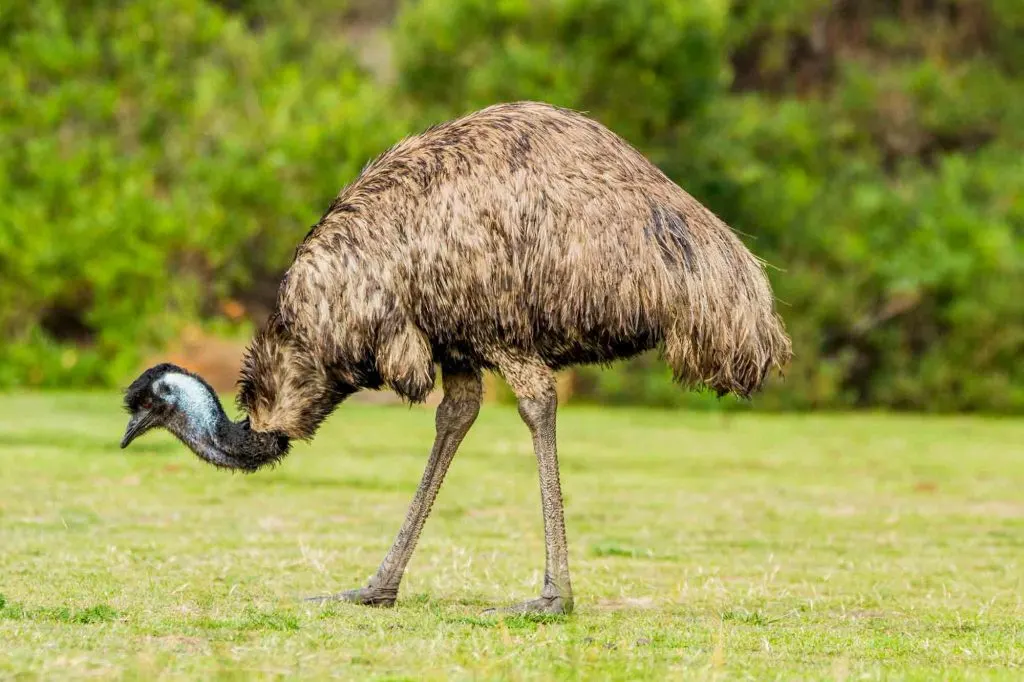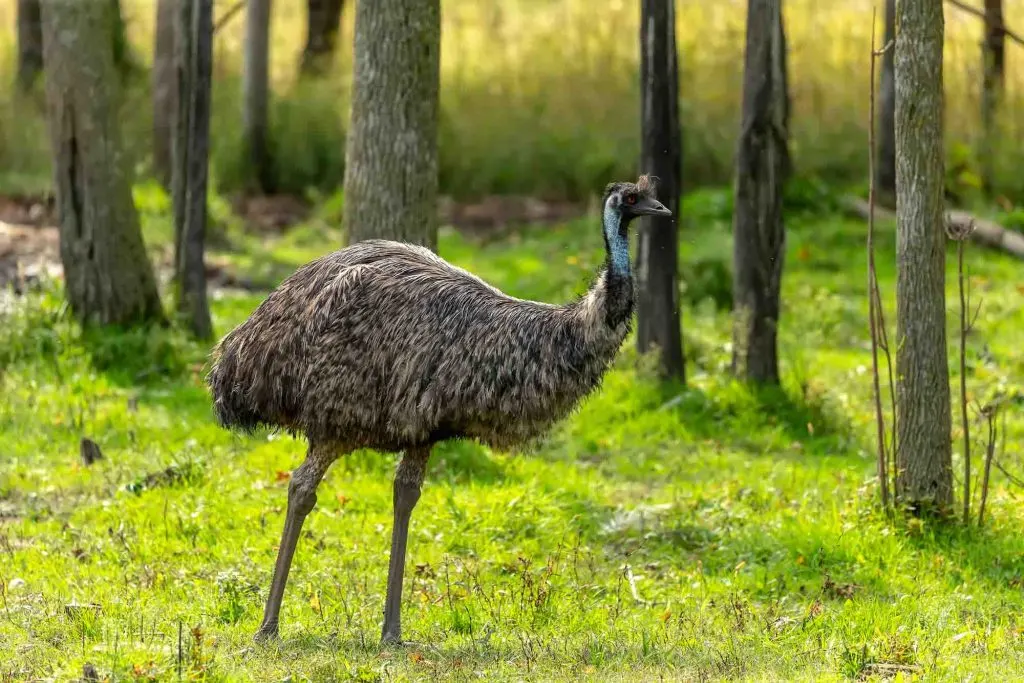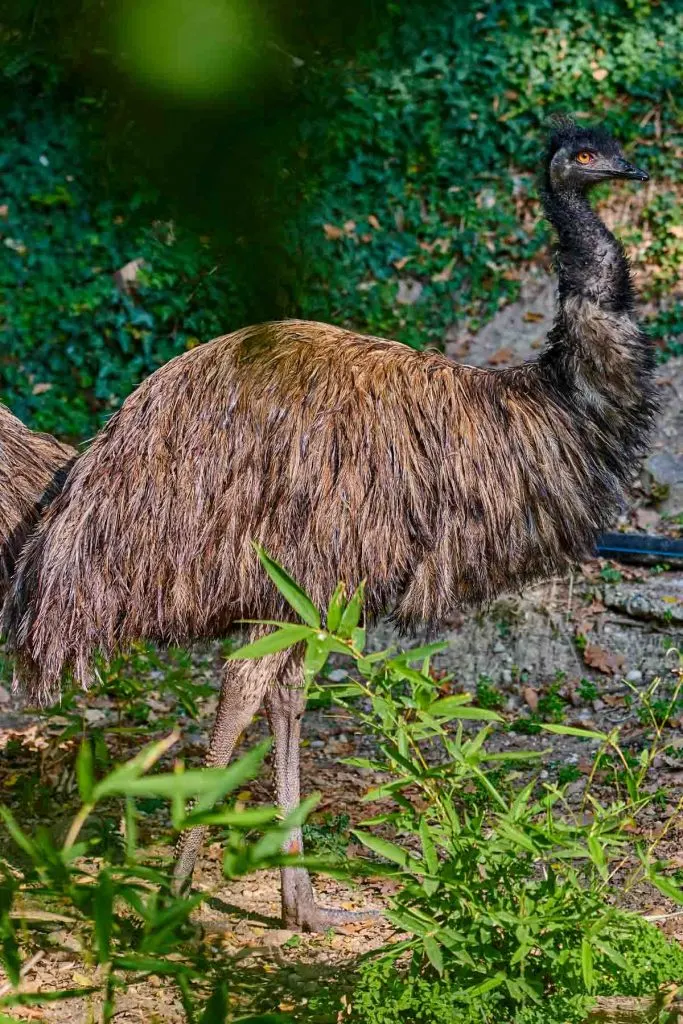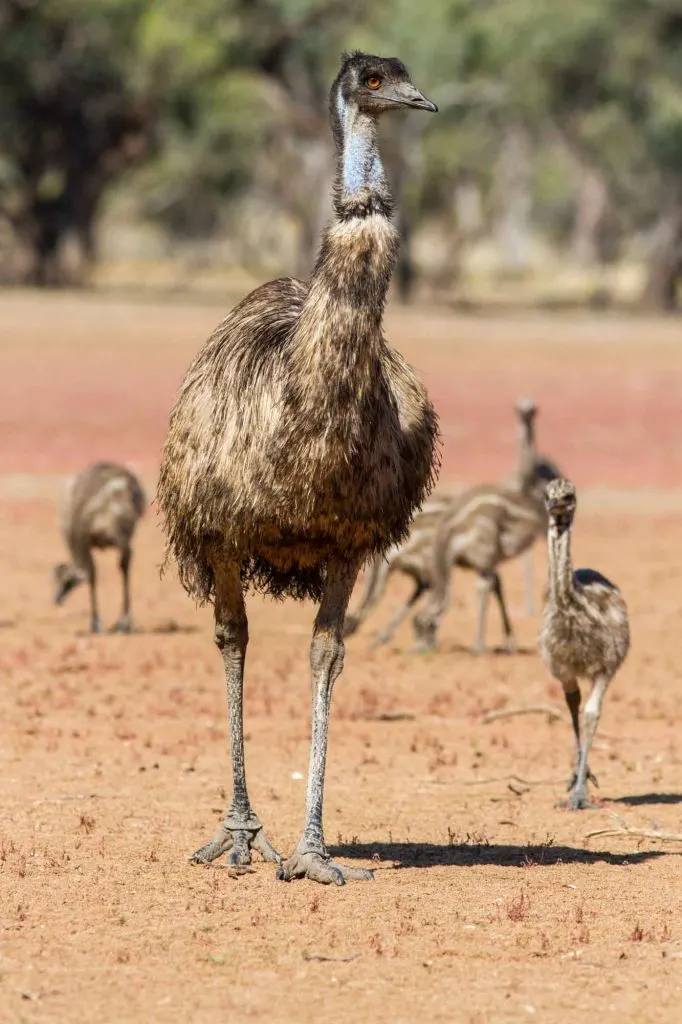Large and not really social, the common emu is a flightless bird and one of the most famous animals of Australia.

Common Emu
Dromaius novaehollandiae
Emu Scientific Classification
- Kingdom: Animalia
- Phylum: Chordata
- Class: Aves
- Order: Casuariiformes
- Family: Casuariidae
- Genus: Dromaius
- Species: Dromaius novaehollandiae
Emu Appearance

- Lifespan: 10-20 years
- Length: 4.8 to 5 feet
- Height: 5.2 to 6.2 feet
- Weight: 66 to 100 pounds
- Top speed: 31 mph – one of the fastest birds in the world!
The emu is unmistakable among birds due to its long legs and thickset body. Second only to the ostrich in terms of height, emus are large birds that can grow up to 75 inches. They are also among the heaviest birds alive, weighing about 132 pounds when fully grown.
A female adult emu is usually a bit bigger than a male and can be identified by the width of its rear side. Bodily, both male and female emus are brown, with their heads and necks sporting either a dark gray or bluish color.
Emus have double-shafted feathers, sparse around the neck and stiff at the tail. The feathers are loosely arranged and can seem like hairs if not closely observed.
The juvenile plumage develops at about three months and is blackish and finely barred with brown, the head and neck being especially dark. The facial feathers gradually thin to expose the bluish skin. The adult plumage has developed by about fifteen months.
As flightless birds, the emu’s relatively small wings measure about 8 inches and have tiny claws at the tip. Emus have three toes on each leg, with each toe featuring long, sharp claws. Emus possess a pouch around the neck that enables them to make mating calls.
Did you know? The emu is the second-largest living bird by height, reaching up to 75 inches.
Emu Range & Habitat

Except for Tasmania, where it is extinct, emus are found all over the Oceanian continent. This Australian bird species migrate from north to south, depending on the season.
Thanks to their ability to manipulate their feathers to protect from cold, emus have been found living in Australia’s Snowy Mountains.
While emus are adaptable and can survive in a variety of climate conditions, these birds mostly prefer the warm atmosphere of dry forests and grasslands. Emus can also be found in Indonesia, the Philippines, and New Guinea.
Distribution
- Continents: Oceania
- Countries: Australia
Habitat
Savanna | Shrubland | Grassland
Emu Behavior and Lifestyle

Emus are solitary and diurnal birds whose social side appears either when searching for food or when forced to share nests.
Usually, they feed, preen, and recreate during the day. Dusk is usually a period of reduced activity for the emu, as it prepares to sleep at night.
Emus sleep for about seven hours, waking up at intervals to feed or pass waste. Emus, individually or in groups, generally range on foot, their long legs enabling them to achieve a speed of about 30mph.
These flightless birds can also climb fences or trees and even swim when they need to.
Emu Diet
Emus typically search for food in the daytime and are omnivorous. Their diet can depend on many things like season and location. They eat insects like ants, grasshoppers, crickets, spiders, and so on.
In winter, emus feed on flowers, fruits, and seeds. Crops like wheat, reptiles like lizards and small snakes, and animal droppings are all on the emu’s menu. Emus have also been known to favor a meal of grass shoots during the rainy season.
Having no teeth, emus have to eat their food whole. To aid digestion, however, they swallow stones that crush the food in their gizzard.
Emus are constantly on the move, traveling up to 15 miles daily seeking food and water sources. When searching for food, the usually solitary emu teams up with up to 20 more birds.
Emus don’t drink water often but drink a lot of it when they can, sometimes drinking non-stop for more than ten minutes. When water sources are available, emus can consume close to three gallons a day.
They can also survive for several days without water in times of scarcity.
In captivity, emus tend to be attracted to shiny objects and have been recorded eating things like glass, keys, and jewelry. Some emus have also been observed eating charcoal. While the reason for this is uncertain, researchers speculate that it might be a way of ingesting toxins.
Emu Reproduction and Mating

Breeding season for emus begins around December or January, when the birds pair up. Mating depends on the climate, as emus prefer to nest when it’s coolest. This often falls between April and June.
Mating partners usually stay together until the first batch of eggs is laid. The female can lay anywhere from five to fifteen eggs, with the male having the responsibility of incubating them.
Once the incubation process starts, the polyandrous female may leave and mate with other males. During the incubation period, which lasts for around 60 days, the male does not eat, drink, or defecate, surviving mainly on body fat that has been stored.
Newborn emu chicks are immediately active and can walk around within a few days. However, they remain with their father for close to 7 months, learning how to feed. Young emus reach physical maturity at two years, at which point they leave the family to find breeding partners.
Emu Conservation Status
Least concern[1]
Emu Predators and Threats
The emu’s major predators include wild dogs or dingoes, eagles and hawks, snakes, humans, and crocodiles.
While most of these predators go after the emu for its large eggs, dingoes and humans attack the animal itself for food and other purposes.
For humans, most parts of the emu serve a purpose beyond food. Its fat is used for making oils, its bones can be carved into tools, and its feather is utilized for decorative purposes. However, with the existence of emu farms in recent times, humans no longer hunt emus like before.
Emu Facts
Here are some interesting and fun facts about the emu, Australia’s greatest flightless bird.
- The first-ever incident of identical twin birds was discovered in the emu.
- The common name “emu” is uncertain but is thought to have come from the word “ema,” which is used in Portuguese to denote a large bird akin to an ostrich or crane.
- The bird is featured in numerous aetiological stories told across a number of Australian Indigenous people.
- Australian armed forces lost a war against emus. In 1932, armed forces were deployed to Western Australia, where farmers had complained about emus destroying their crops. After an assault that lasted two months and cost over 10,000 rounds of ammunition, the troops were forced to admit defeat.
- Emus are the only birds whose gastrocnemius muscles have four bellies. Most birds usually have three. This muscle, found at the back of the lower leg, is roughly equivalent to calf muscles in humans.
- From lakes and mountains to creeks and hills, up to 600 locations in Australia are named after the emu.
